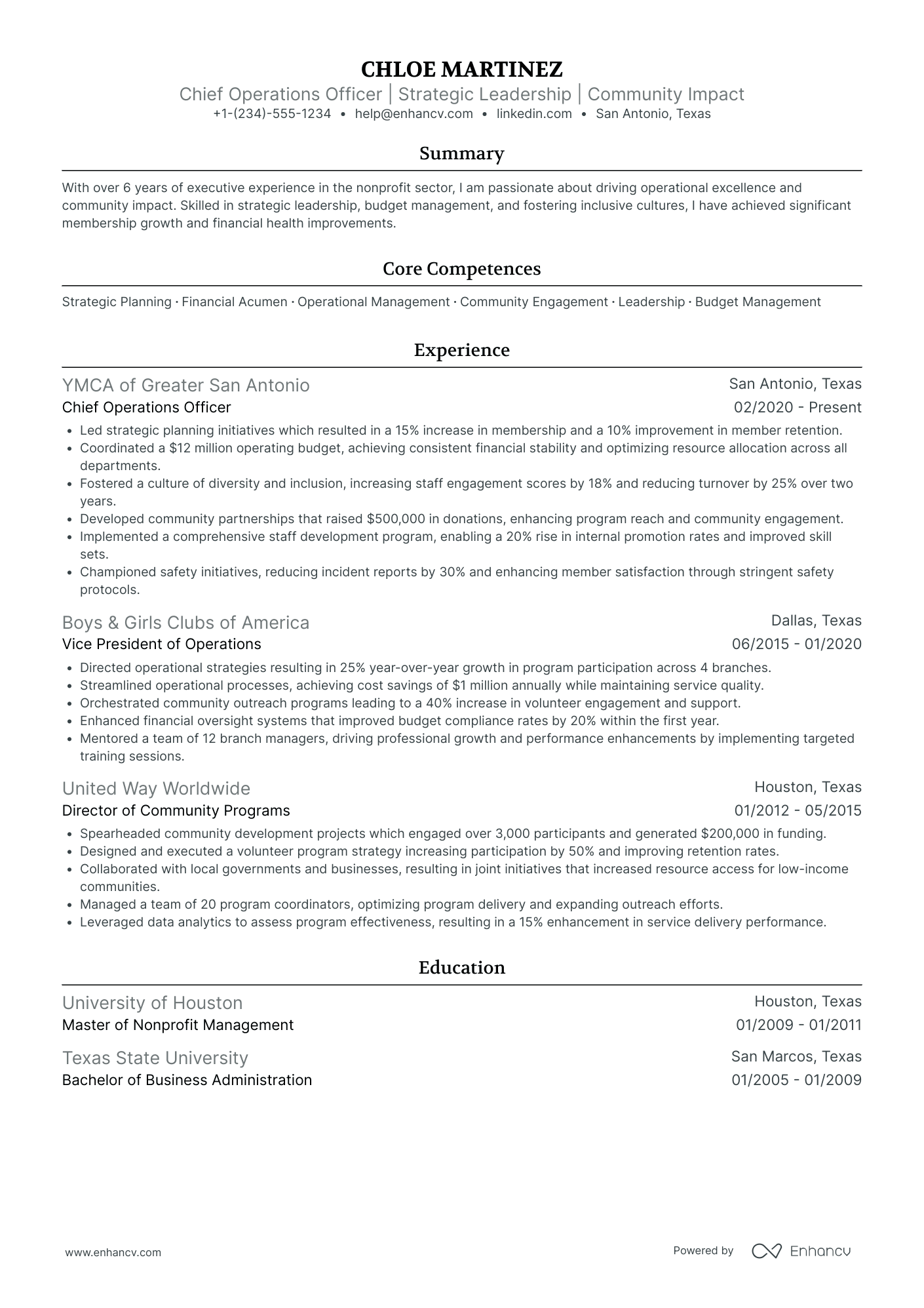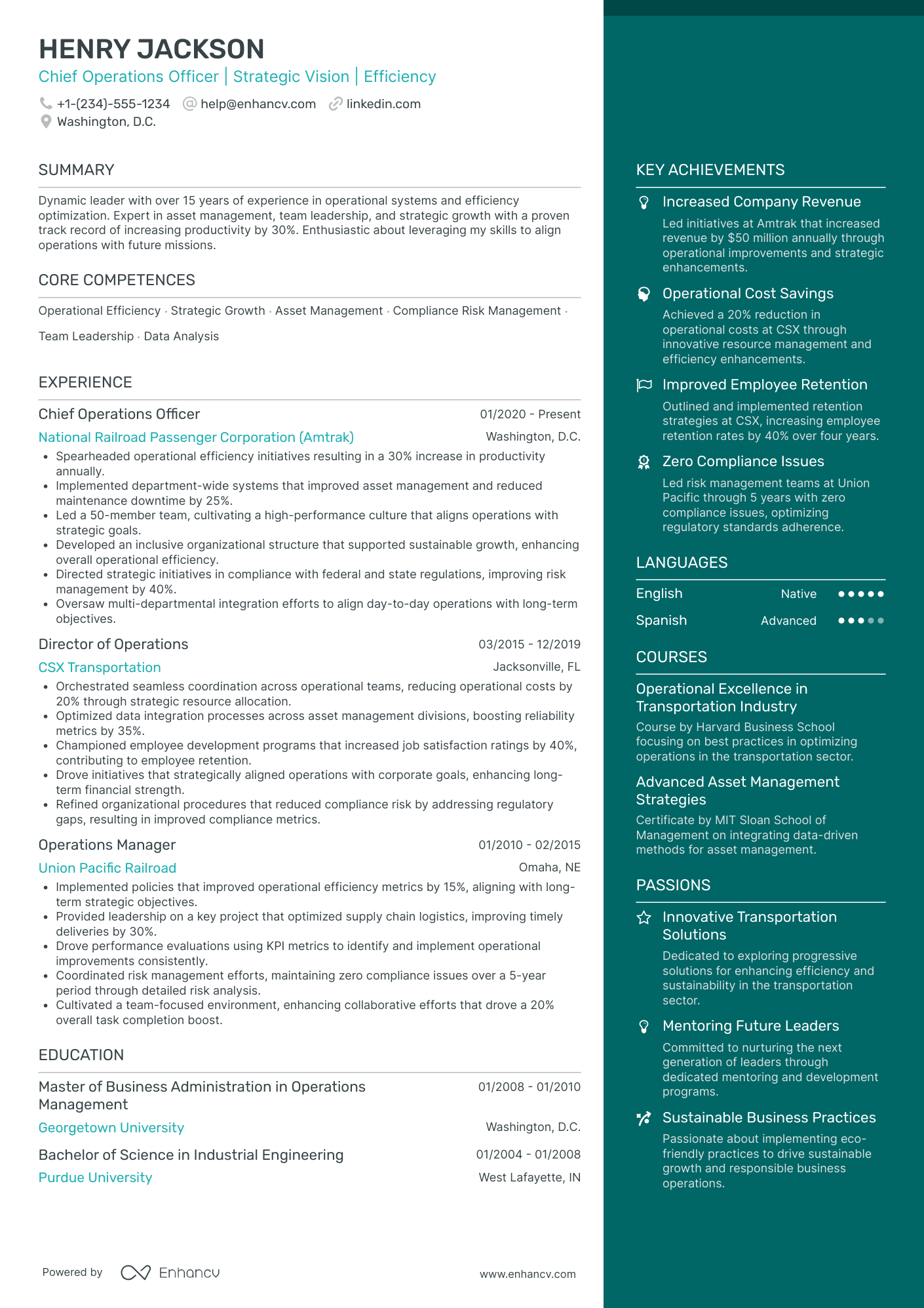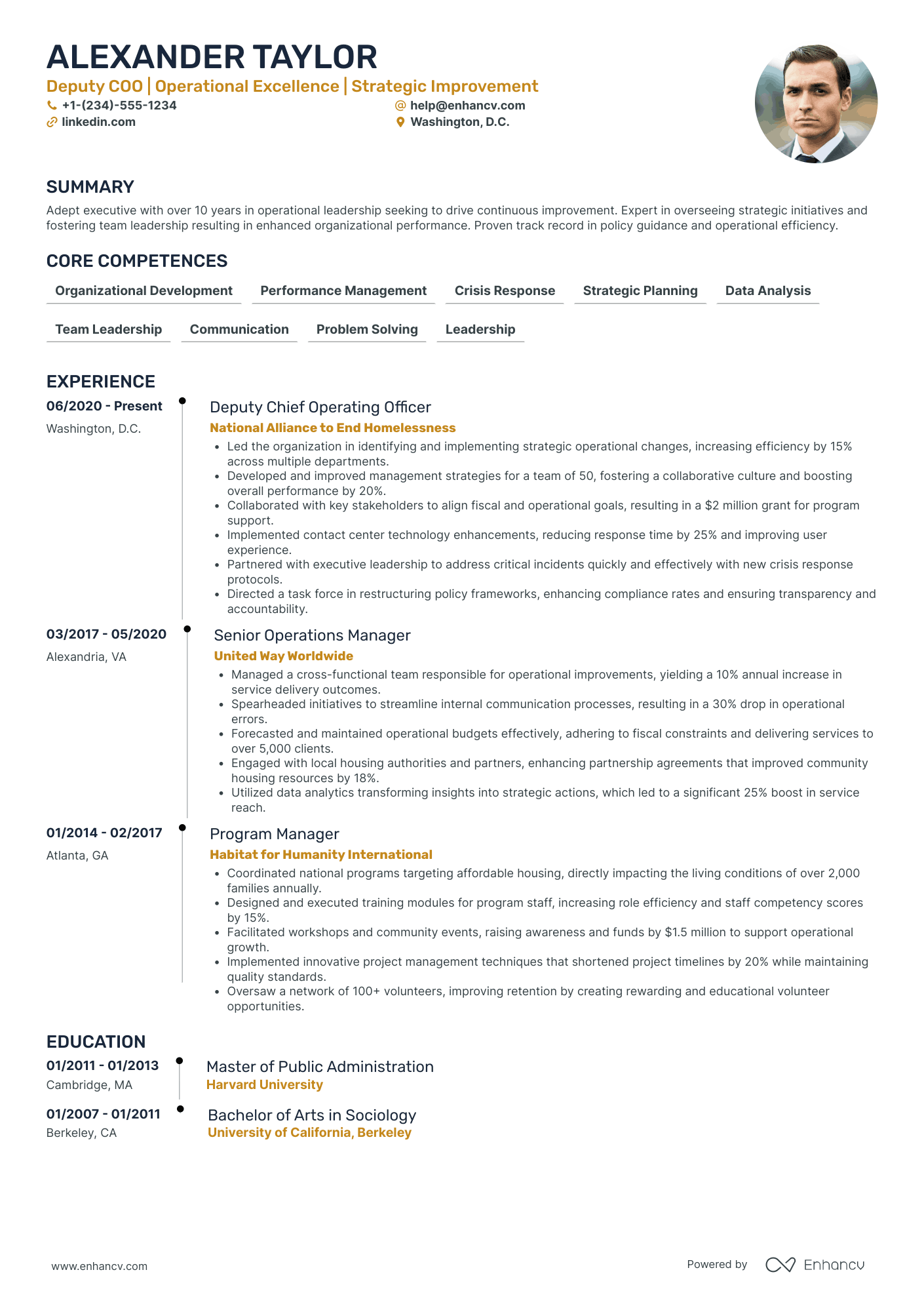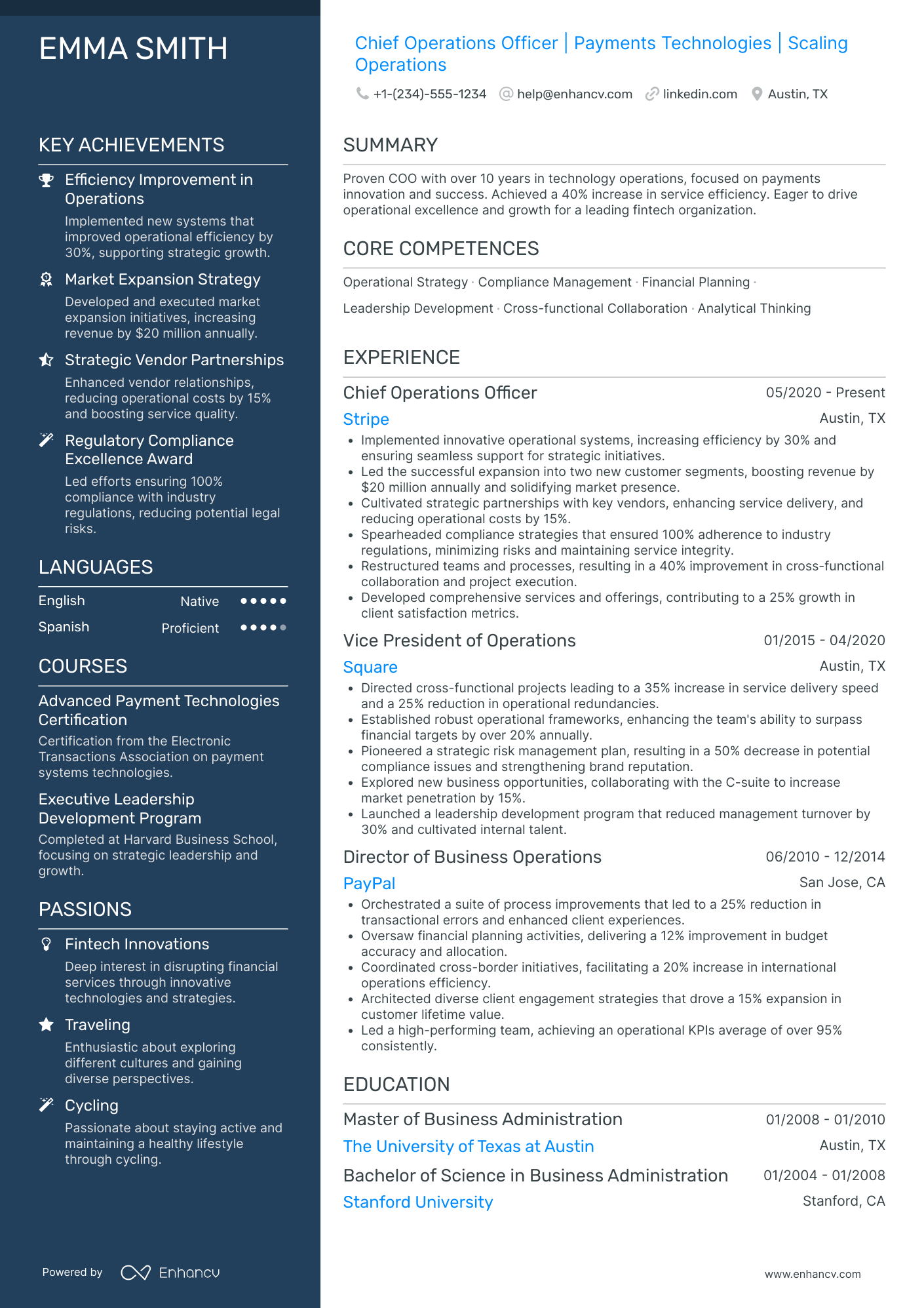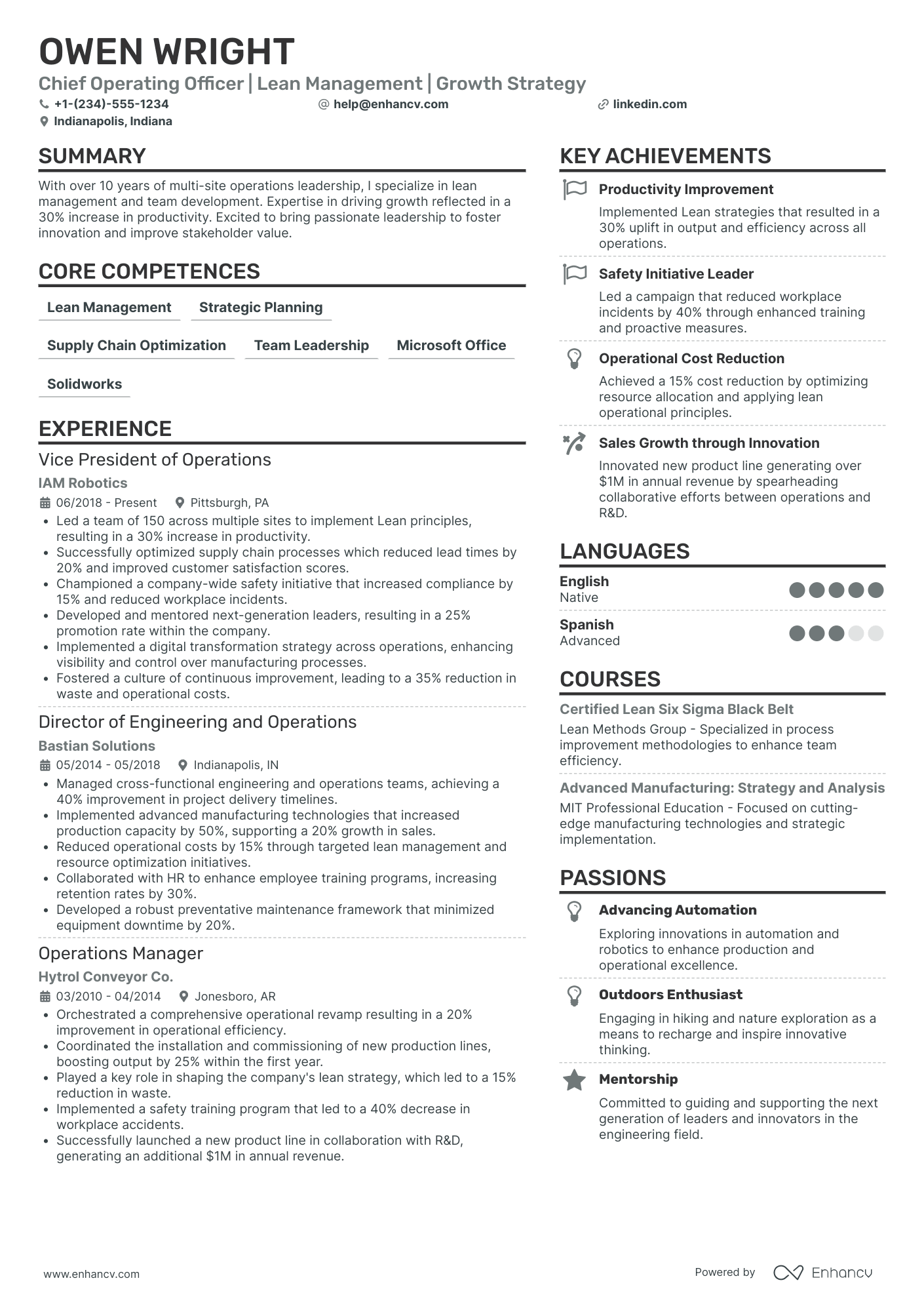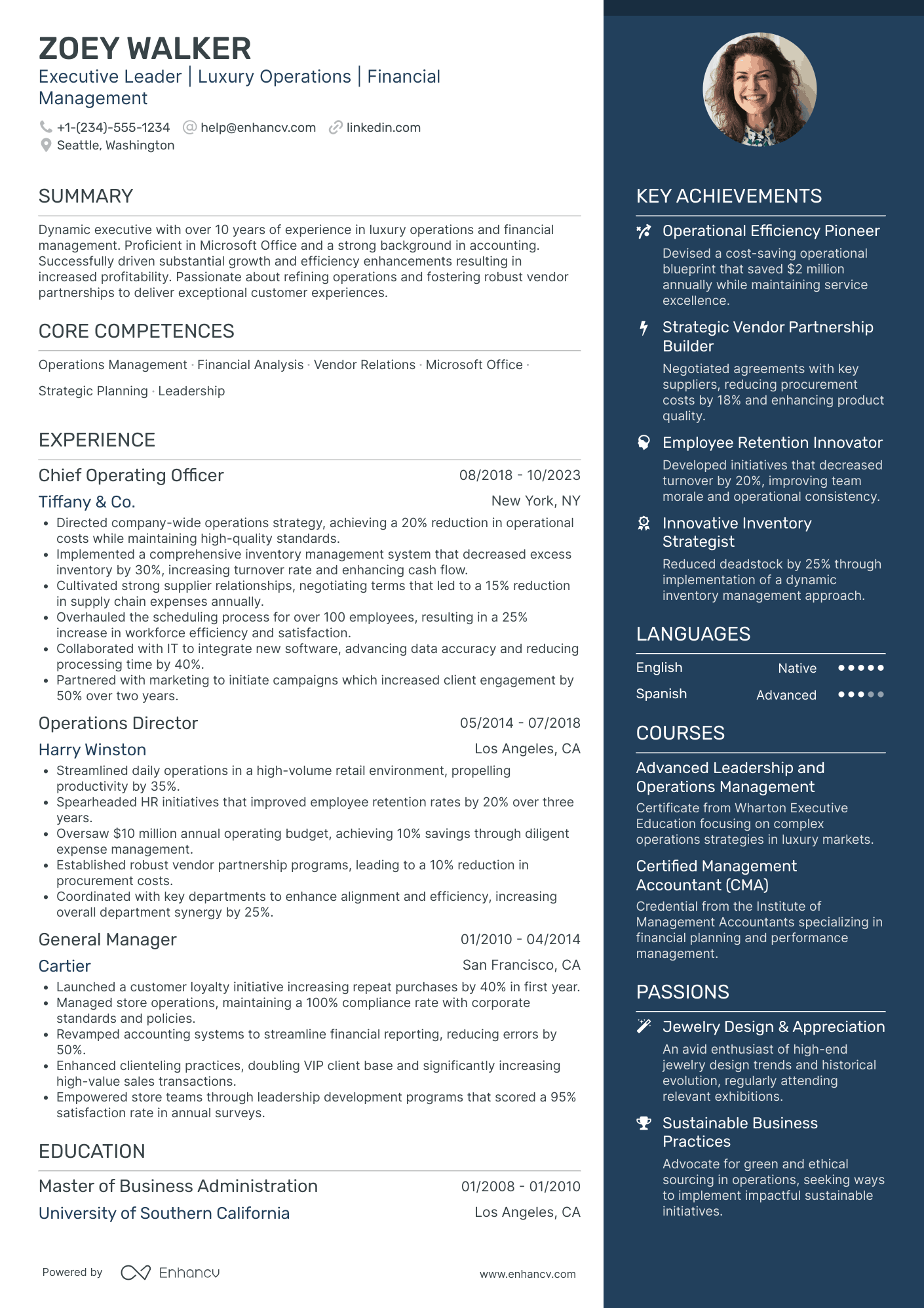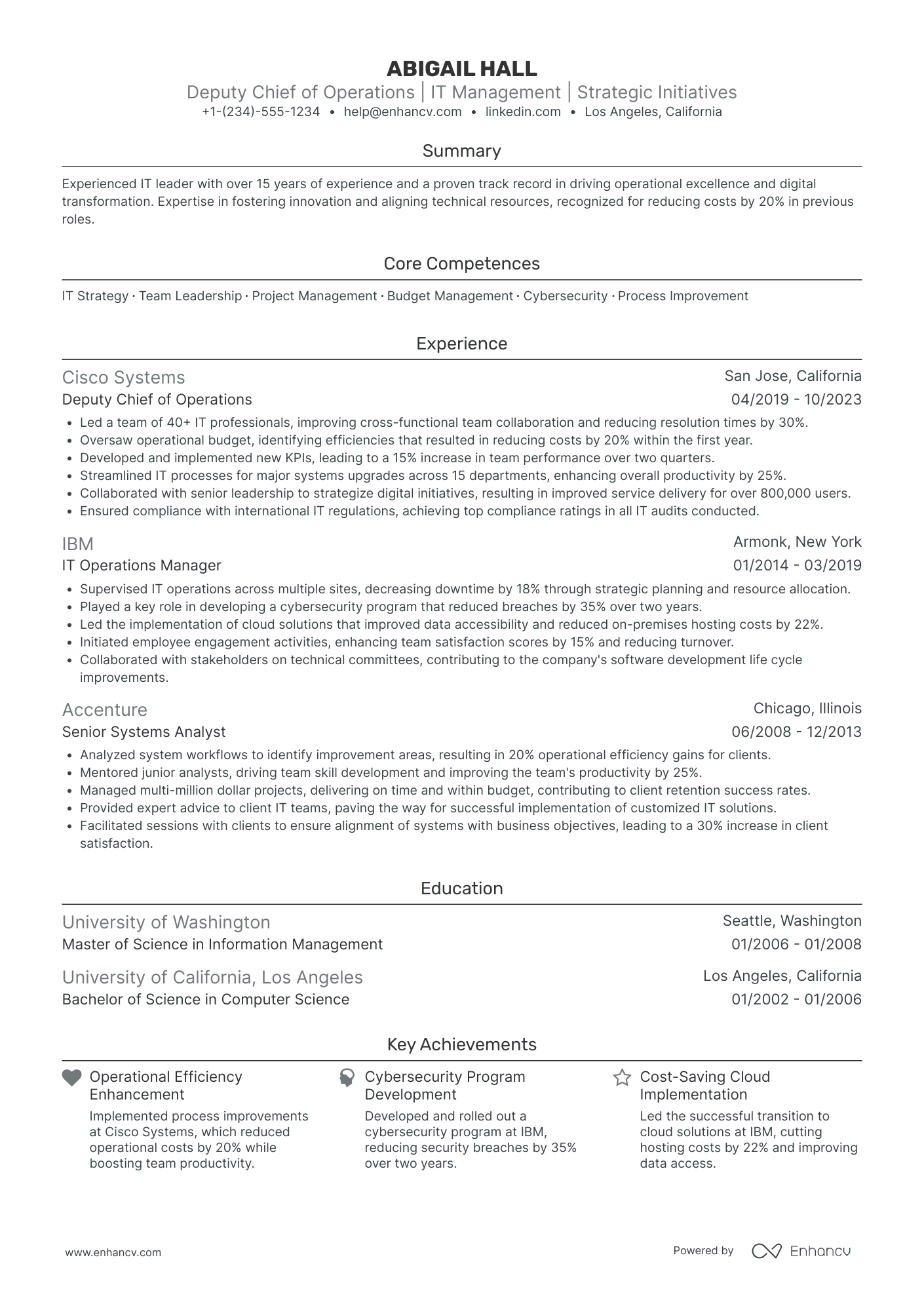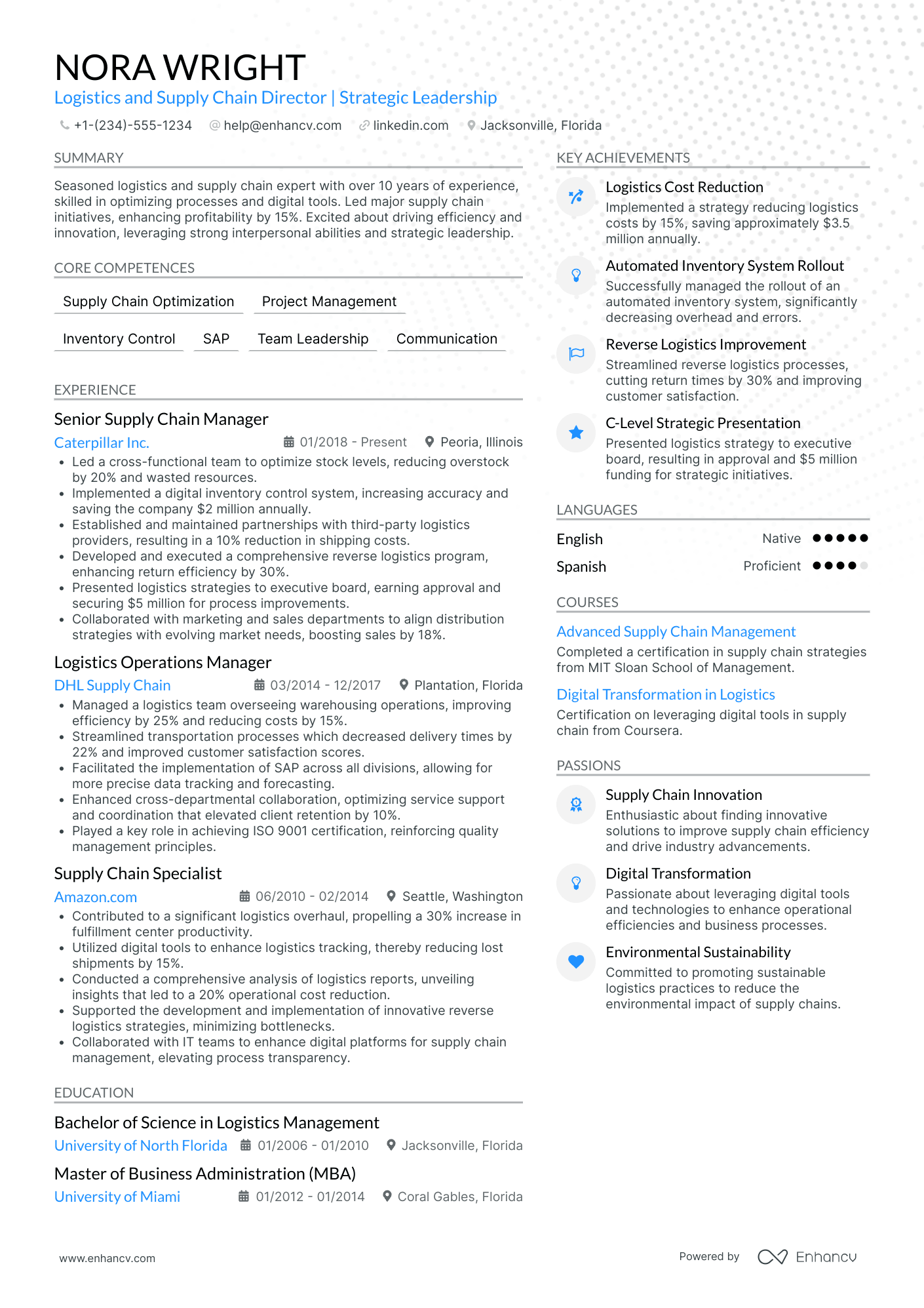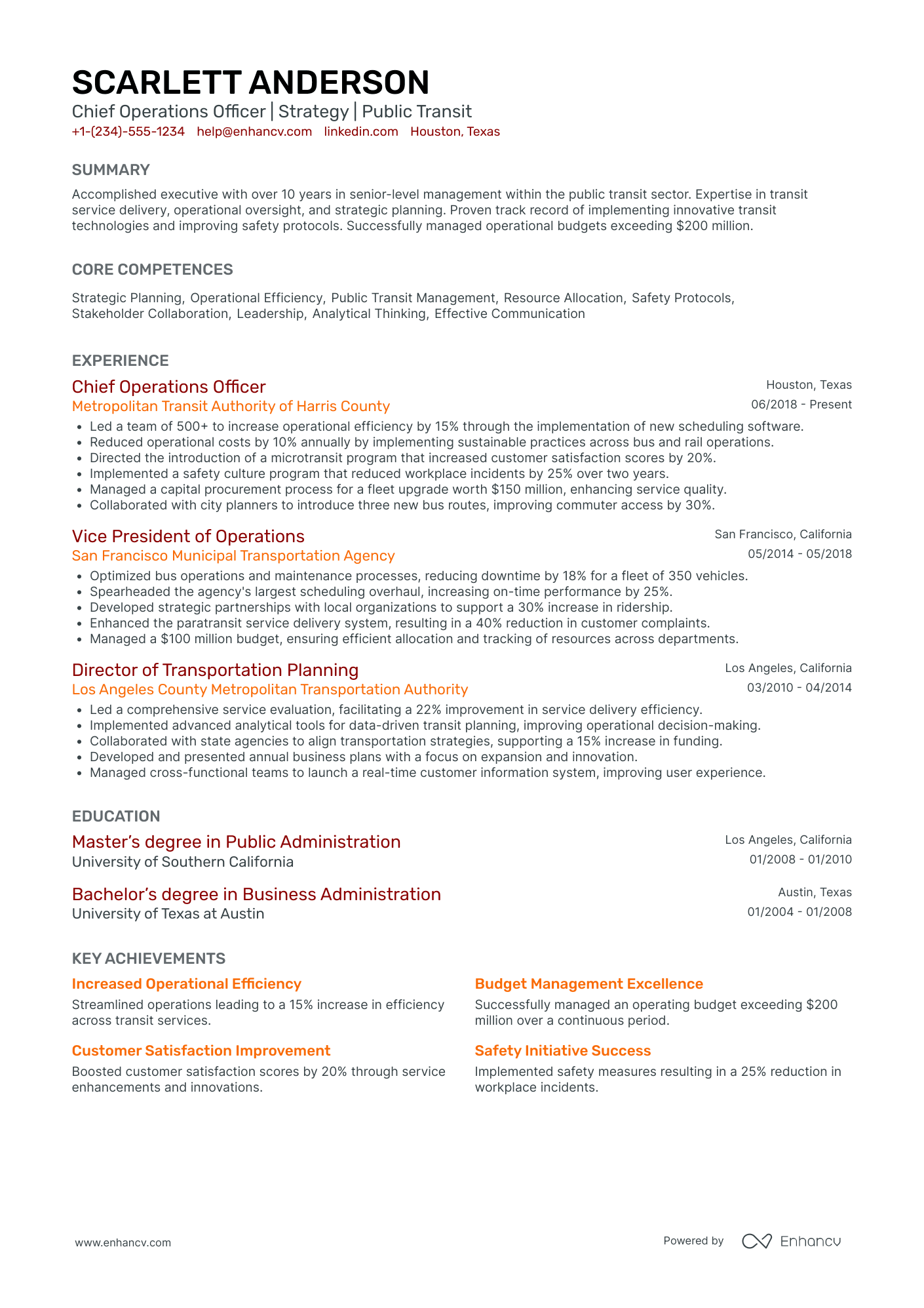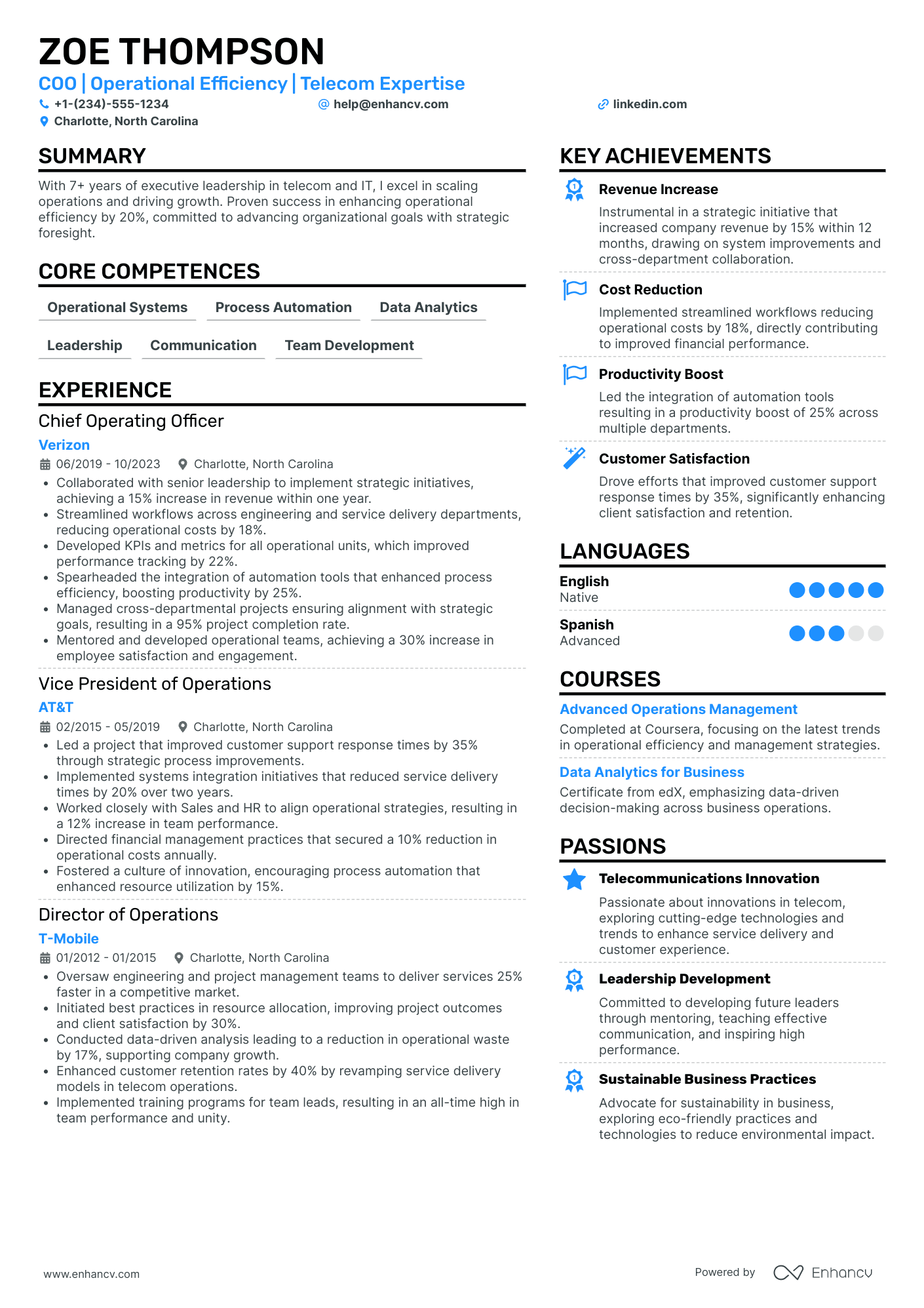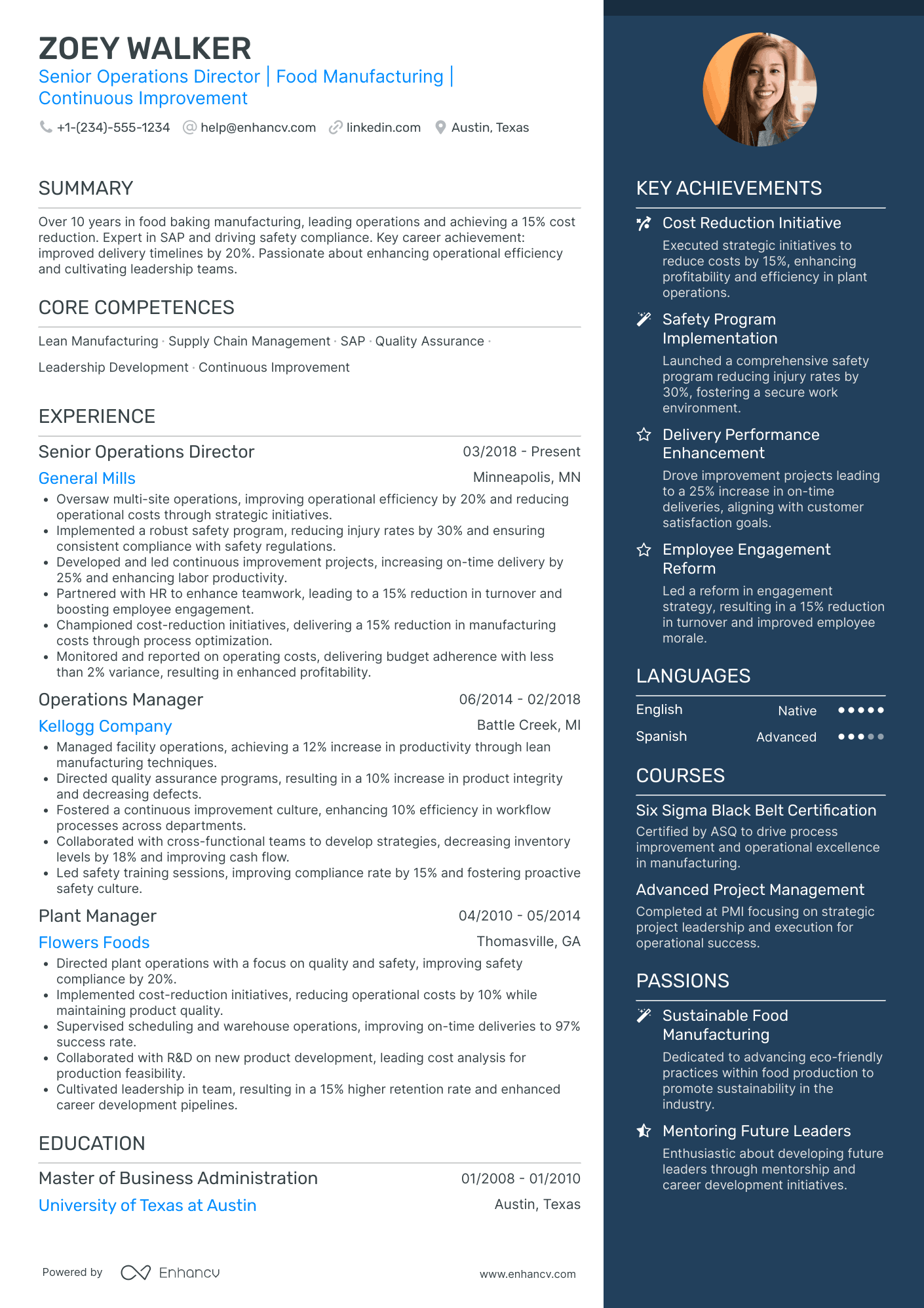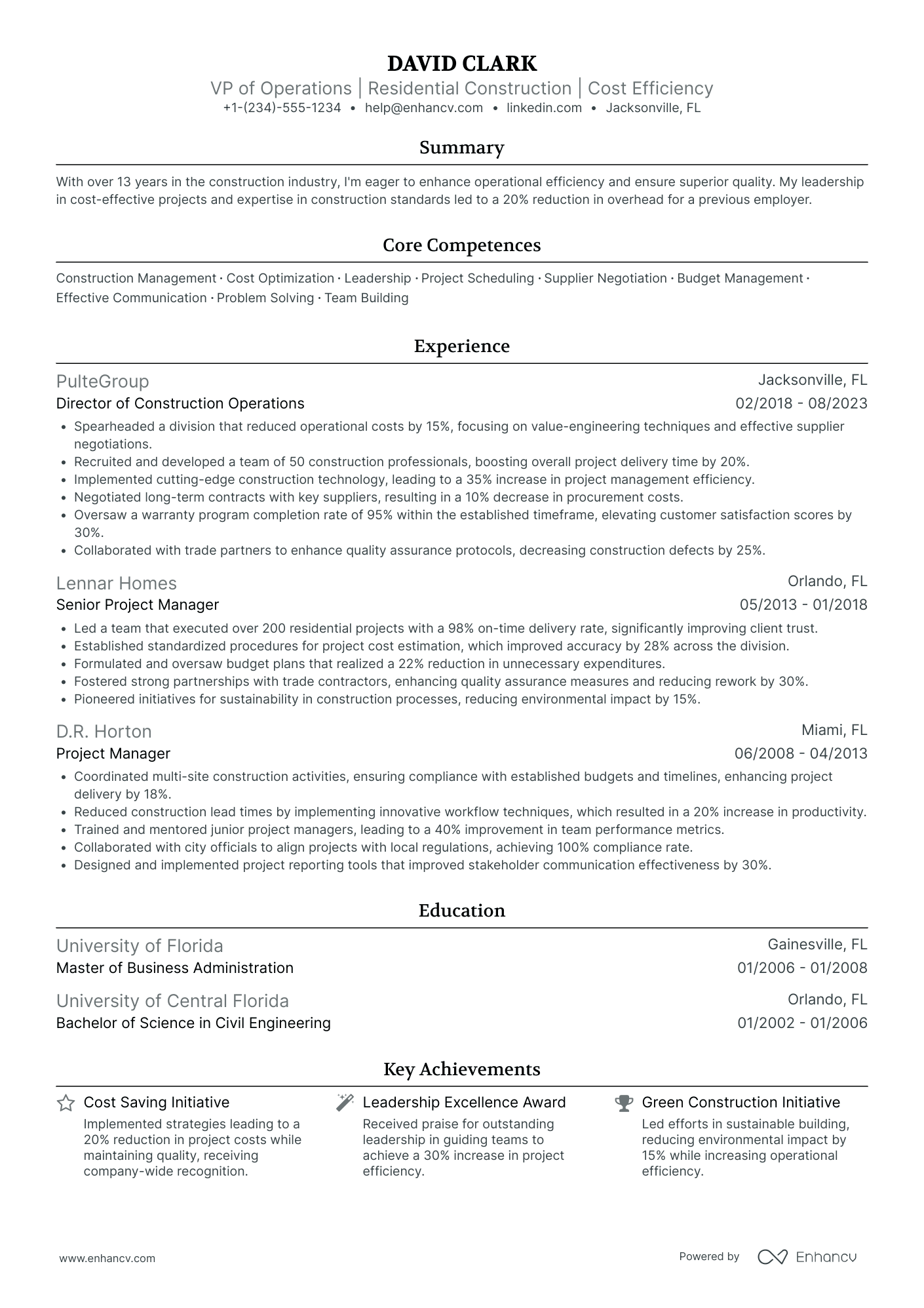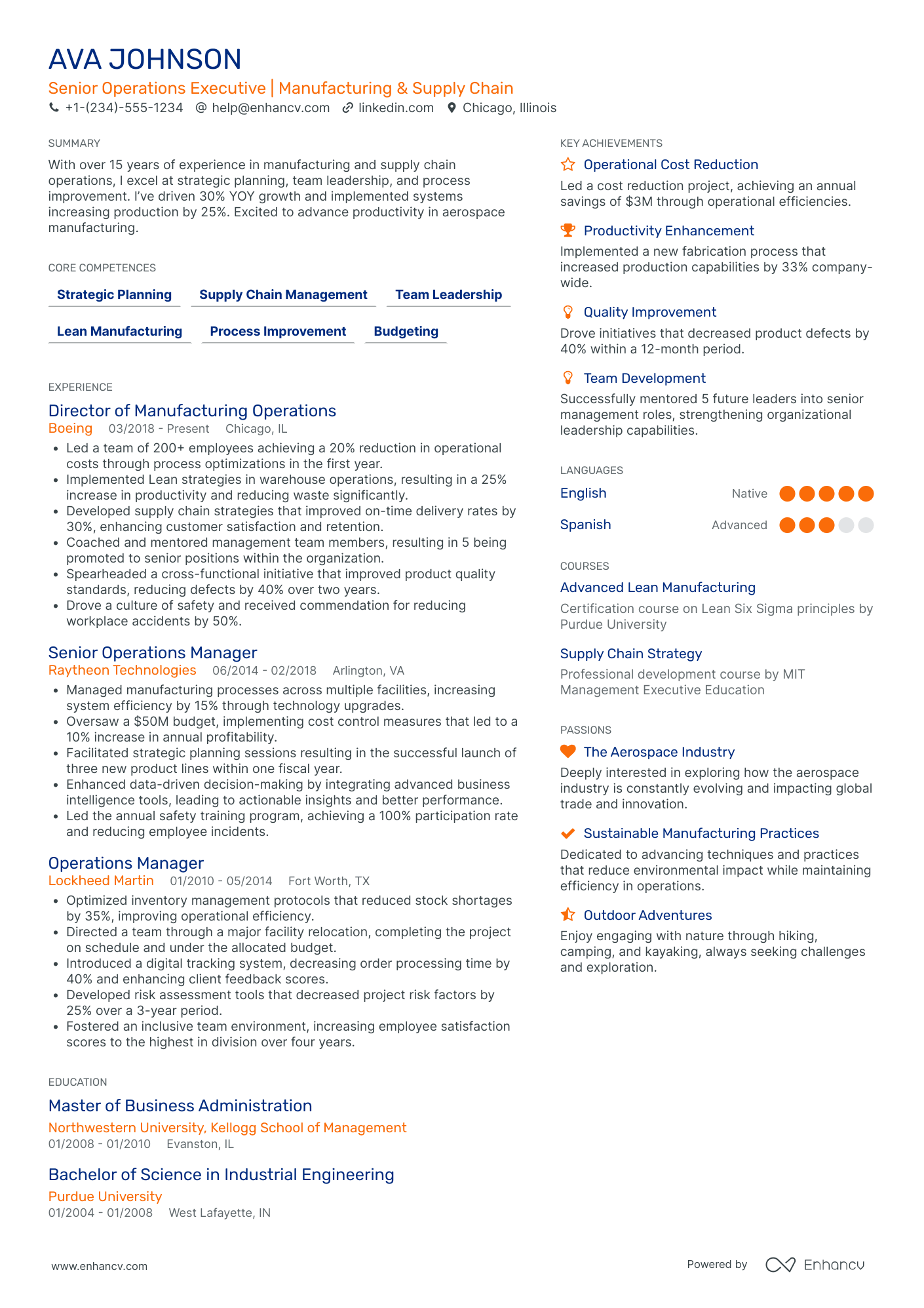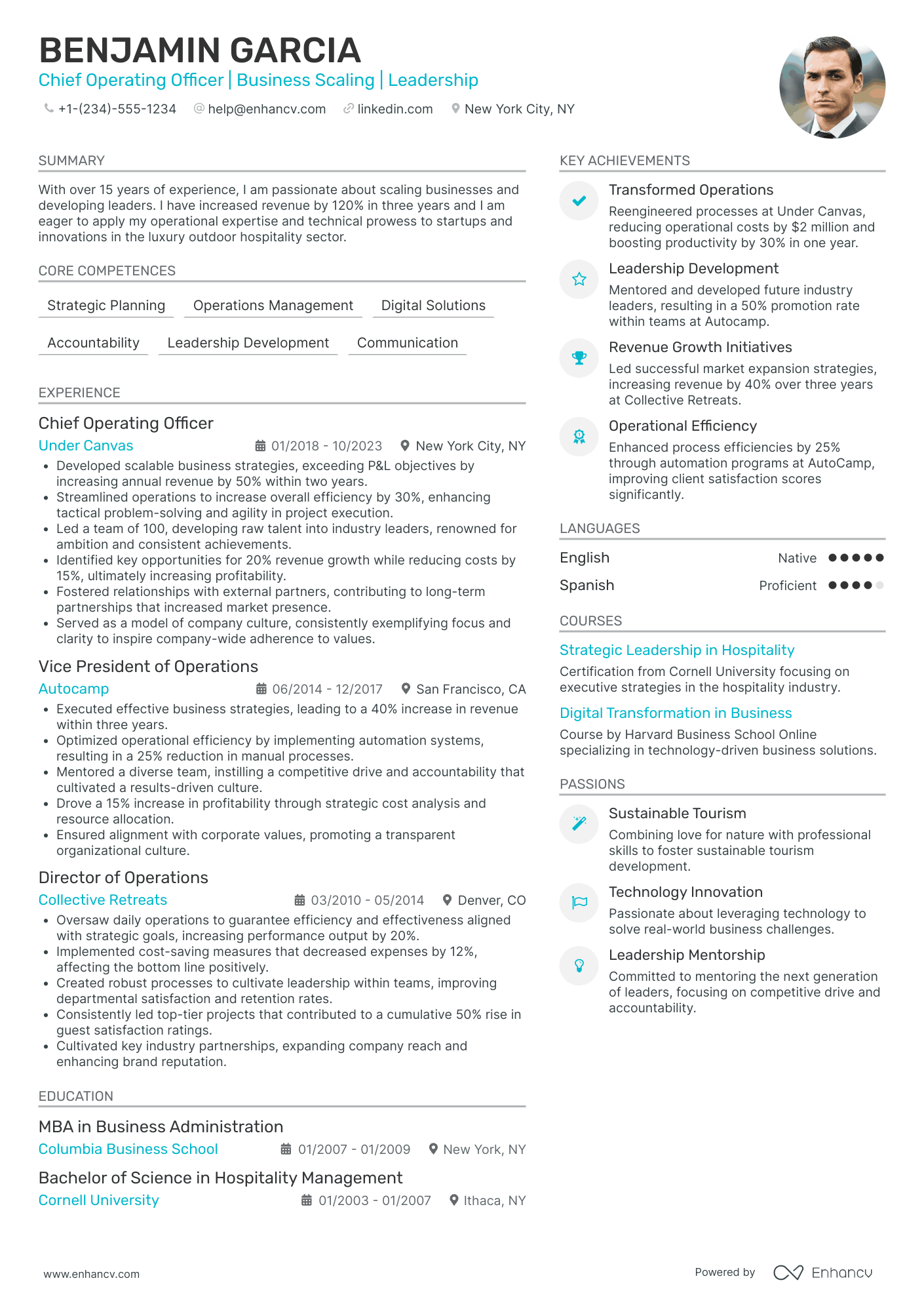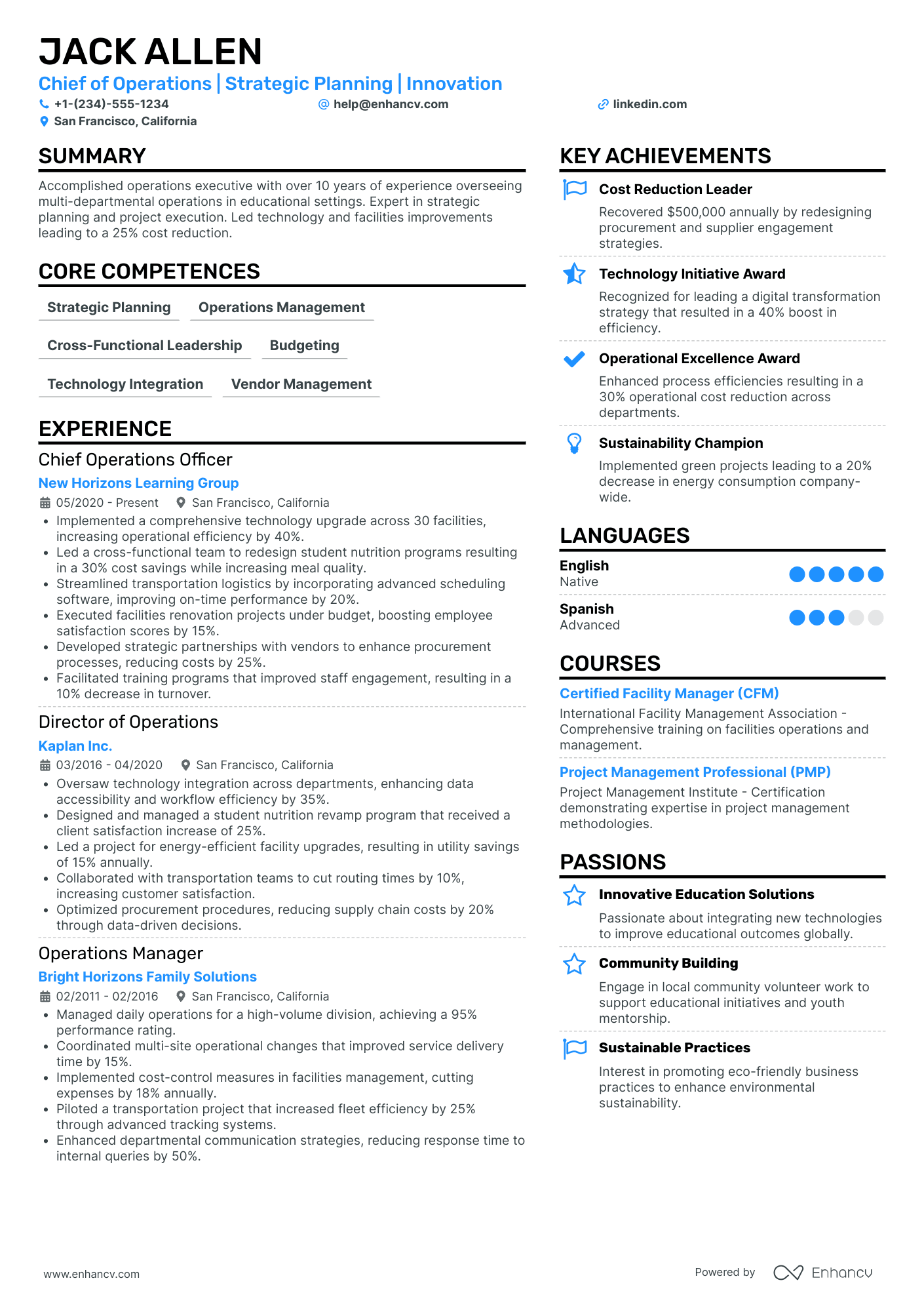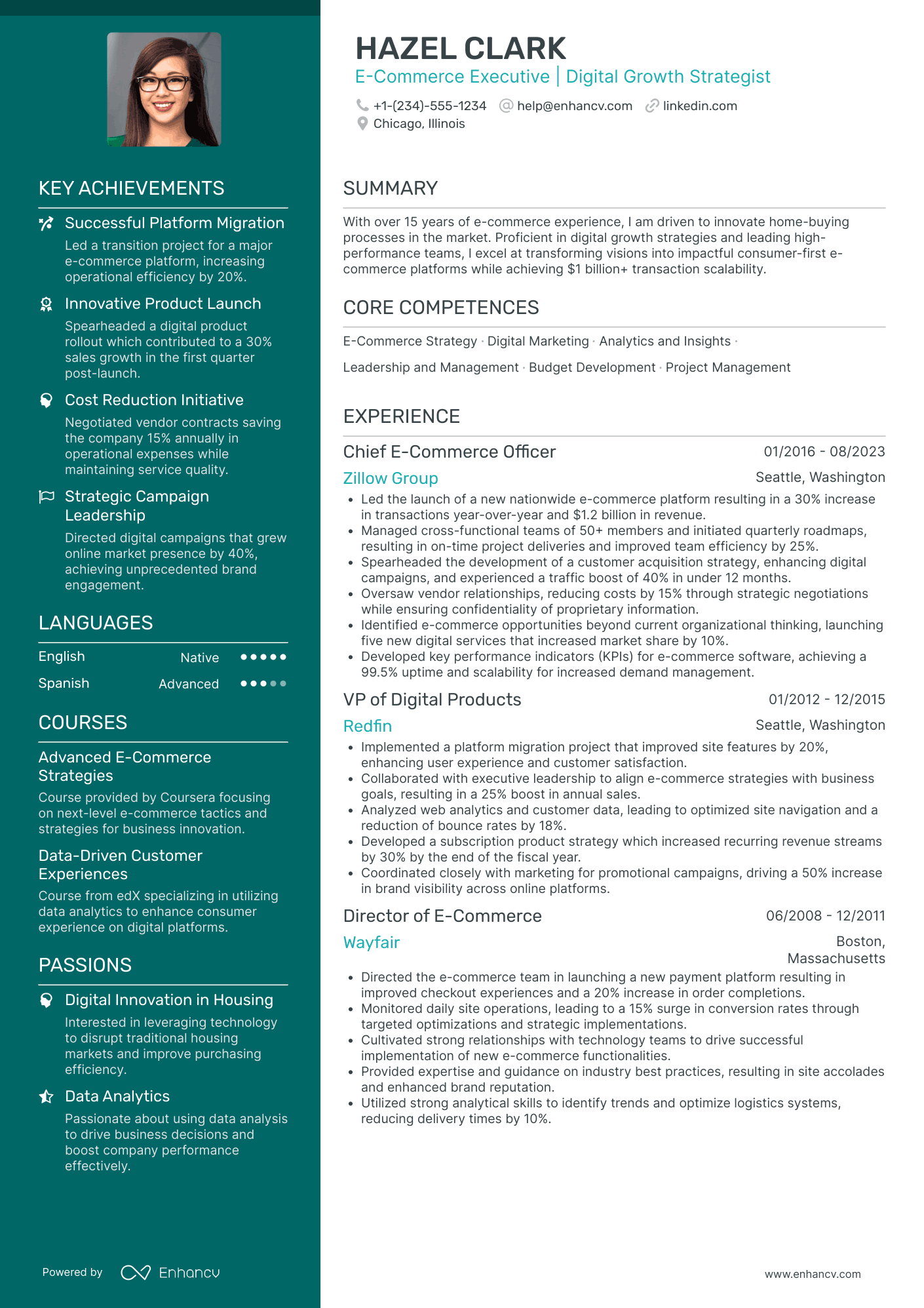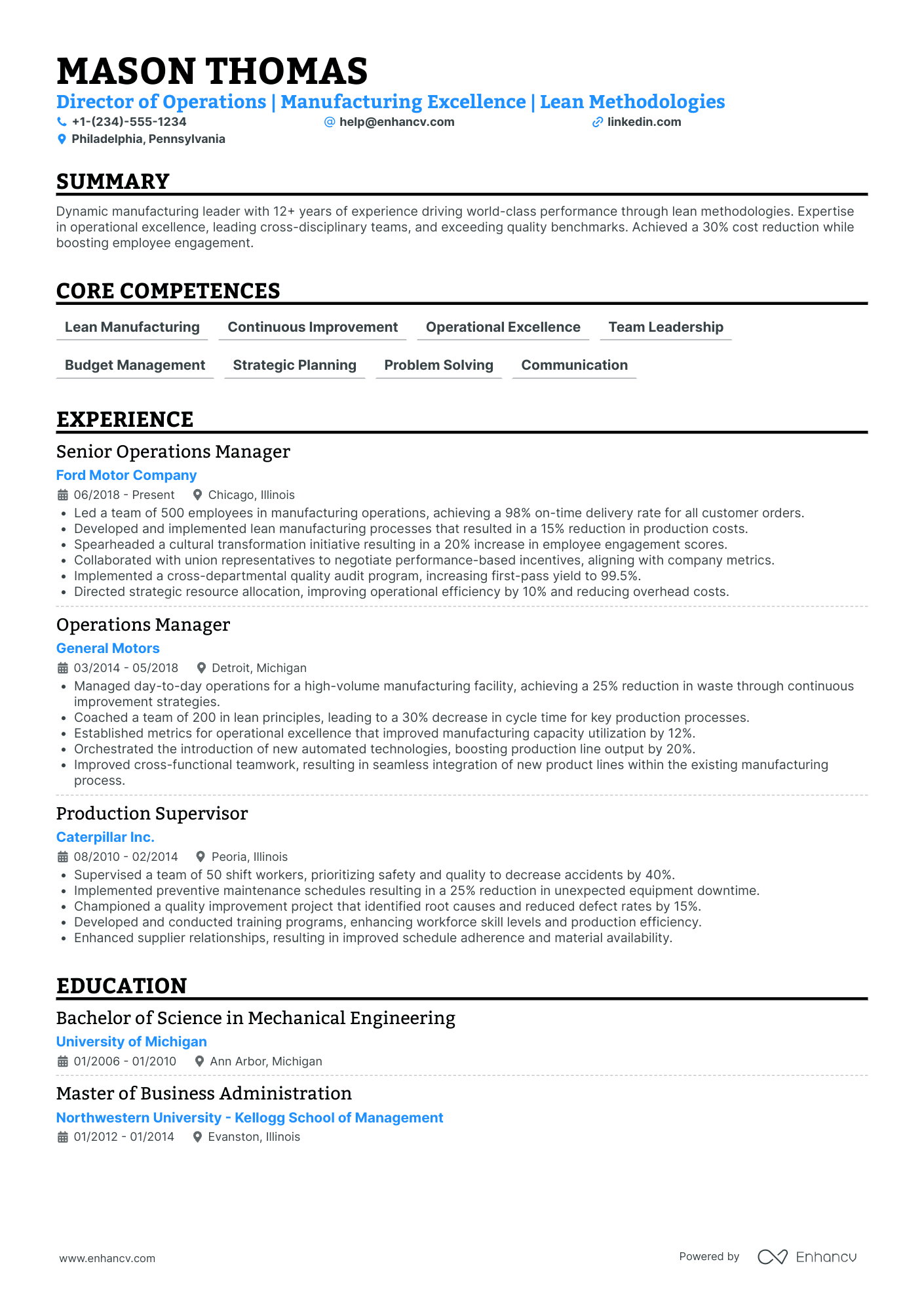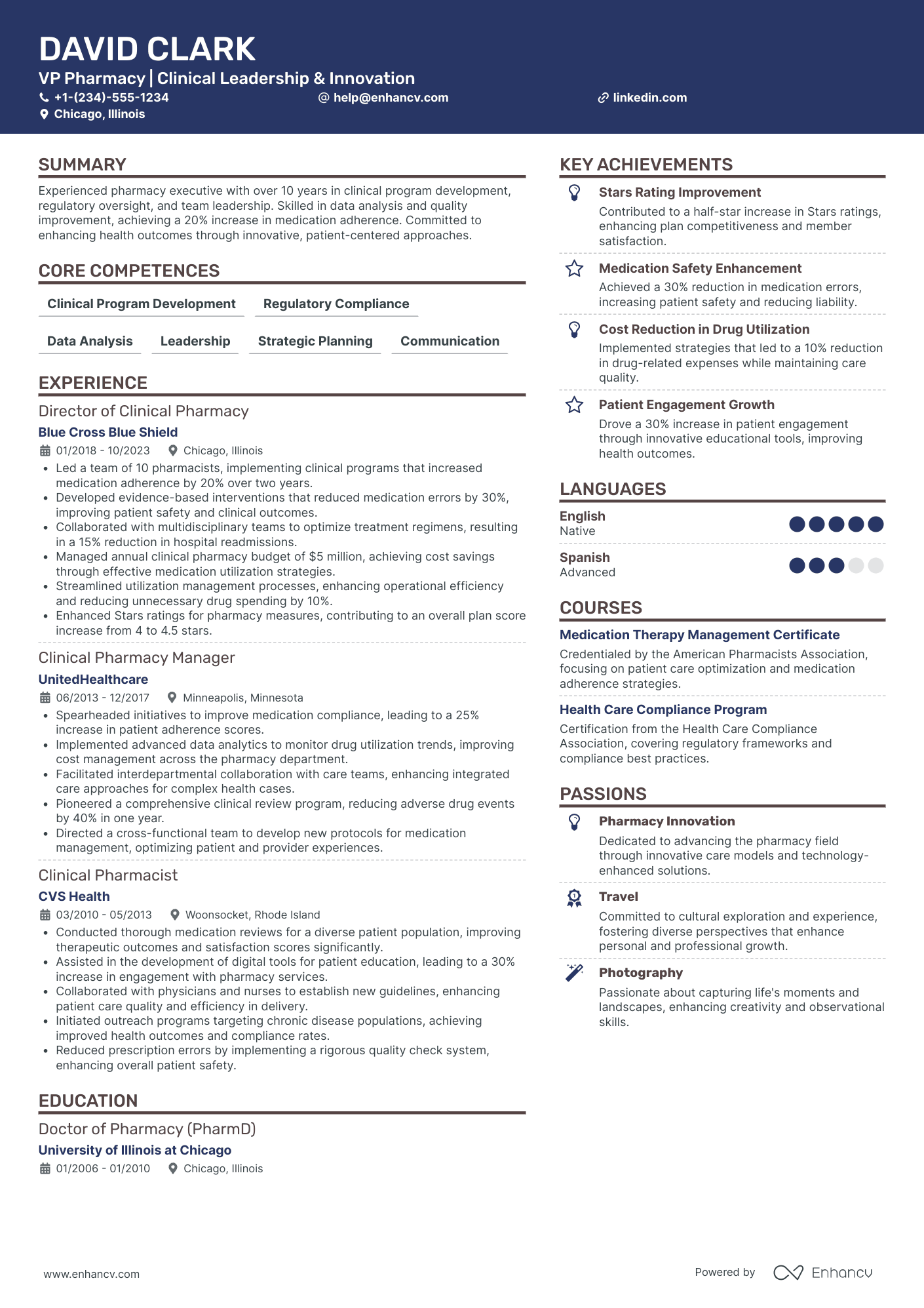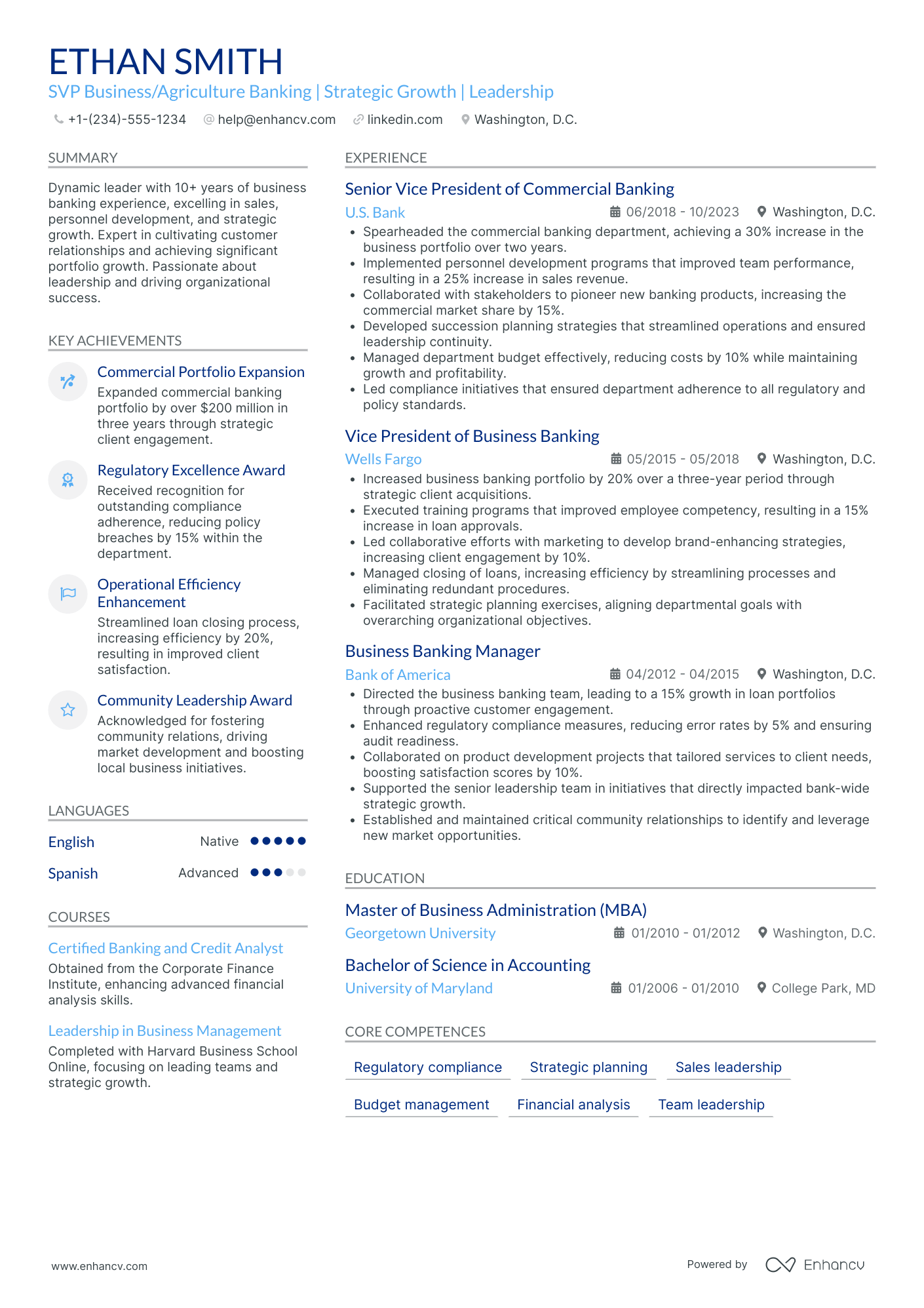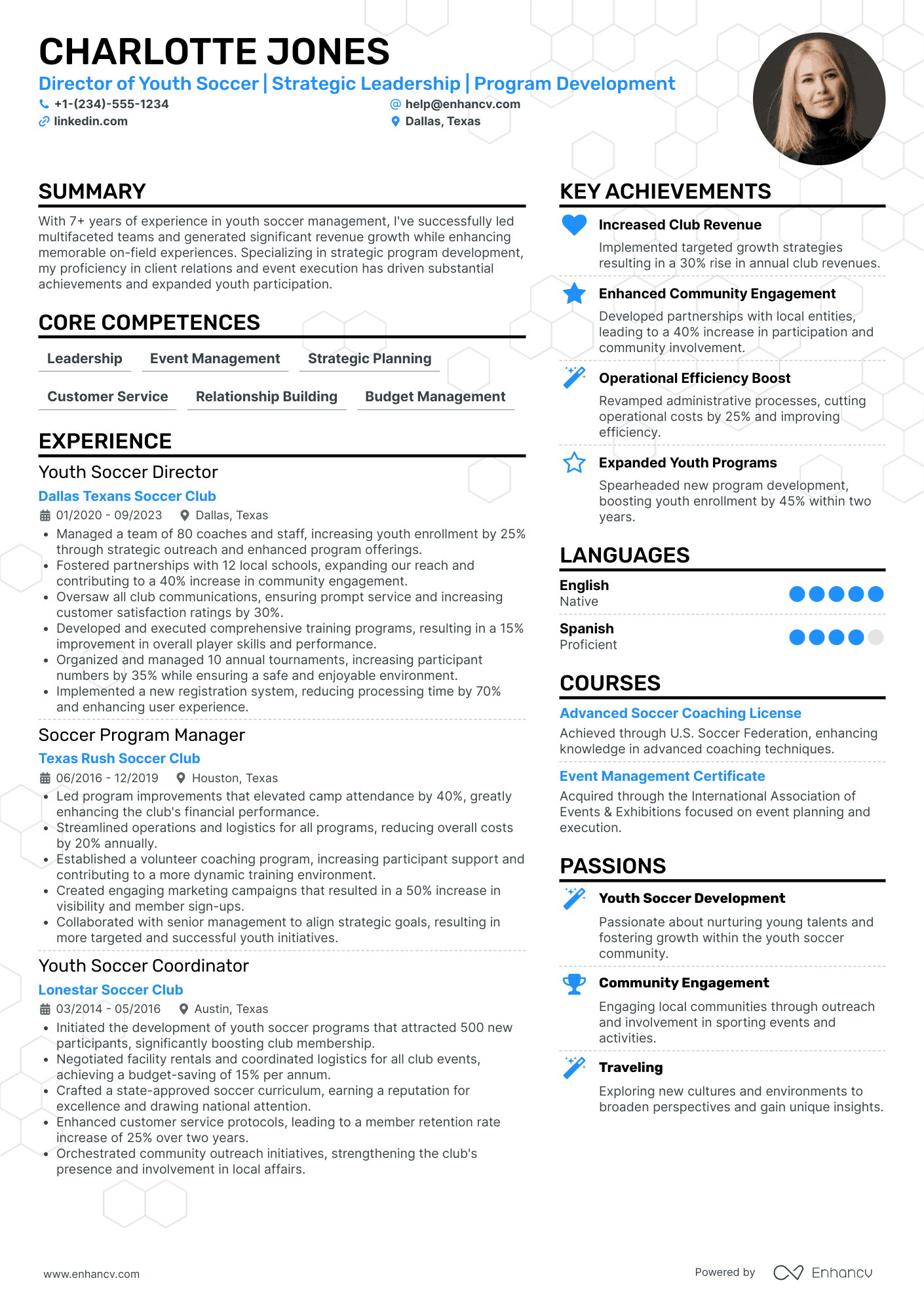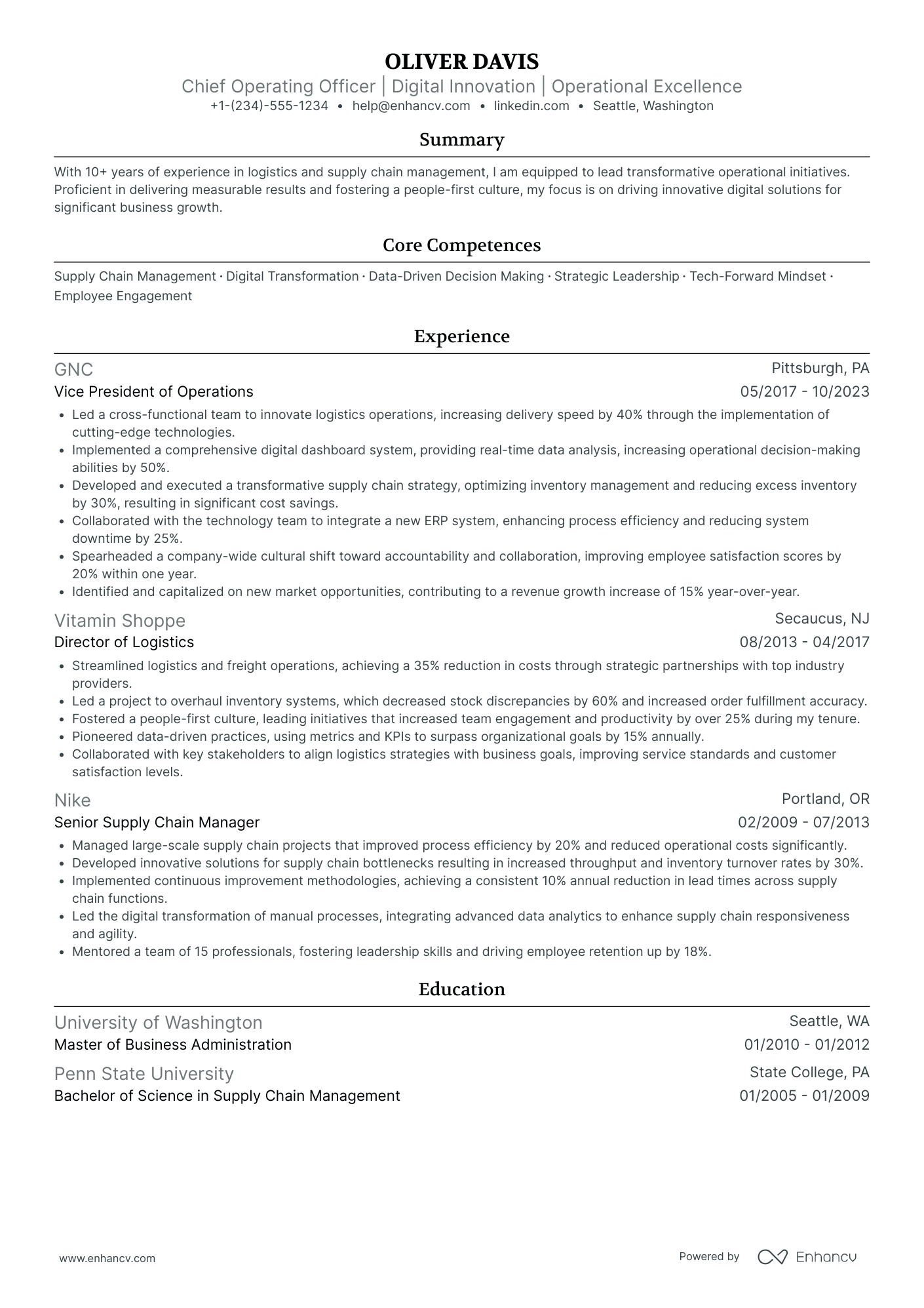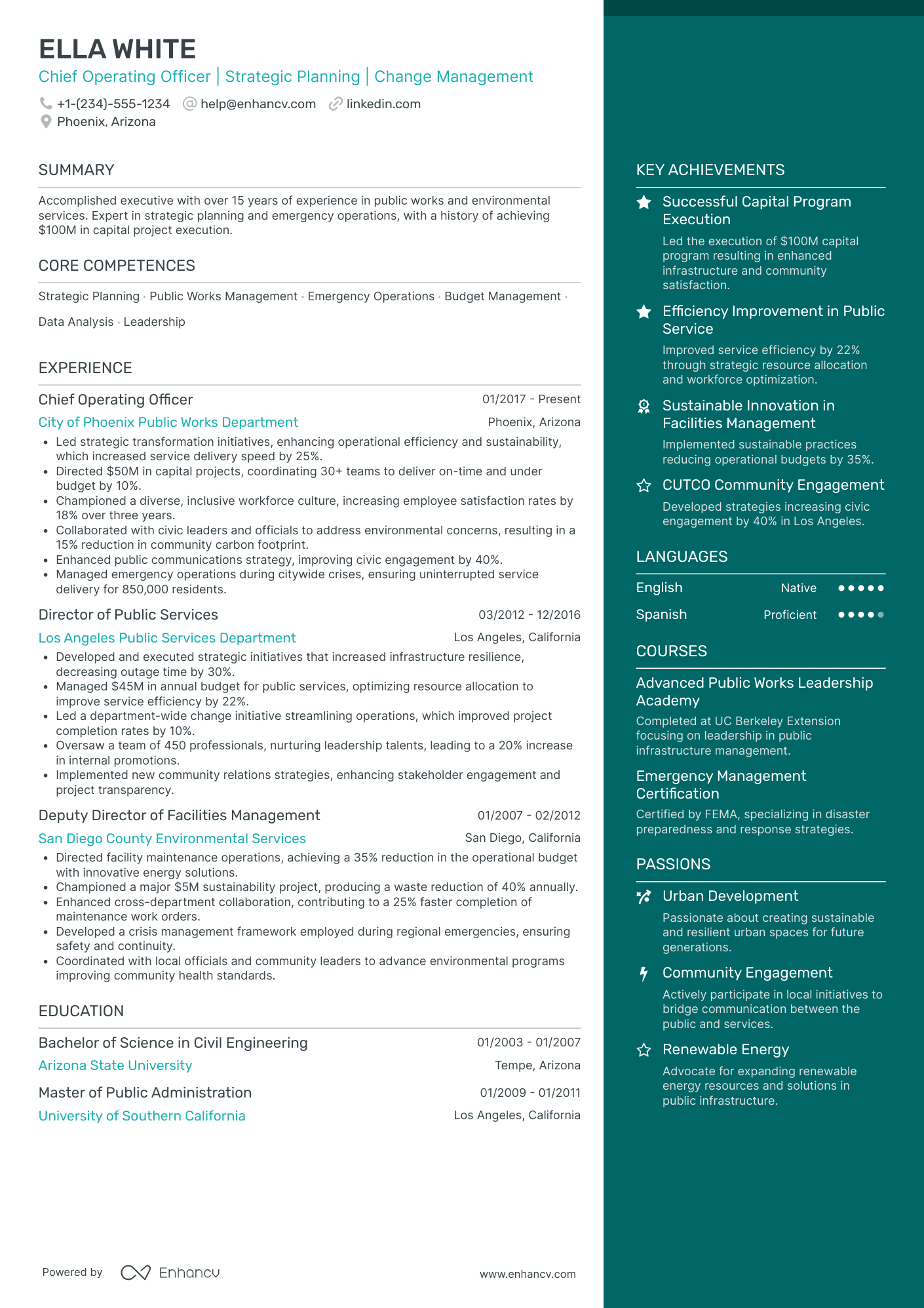The projected job growth rate for COO roles between 2018 and 2028 was about 6%, which shows that companies are as interested as ever in recruiting talented COOs and retaining them for the long run.
However, growth in any field often creates fierce competition. There are more and more new COOs every day hoping to secure ideal positions at their dream companies.
In the face of such competitiveness, you can’t treat your job hunt as a numbers game, even if you are an experienced chief operations officer. You must learn and apply unique resume-building tactics so you can easily craft a COO resume that gets you noticed.
This chief operations officer resume guide will cover:
- Expert-driven tips on how to format and design your resume
- The most important resume sections and how to organize them
- The best ways to feature core skills and managerial experience
- Real-world COO resume examples to keep you inspired in your job hunt.
If you’re interested in additional C-level resume examples, refer to the short list below or search our website:
- CEO Resume
- CFO Resume
- CTO Resume
- Chief Product Officer Resume
- Chief Marketing Officer Resume
- Chief Human Resources Officer Resume
- Chief of Staff Resume
- COO Cover Letter
Ready? Let’s get started.
How to format a chief operating officer (coo) resume
When applying for a COO position, you need to build a resume that goes beyond providing a summary of your expertise and skills. A job-winning is a strategic tool that sets the stage for your career advancement despite the competitiveness of executive job hunting.
The way you format your resume is crucial in conveying a clear, professional message to potential employers. Design and layout will also significantly impact how hiring managers view and evaluate your credentials. A well-structured resume is the best way to ensure that your extensive experience and skills as a COO are presented most compellingly.
Essential tips when formatting a COO resume:
- Use the reverse chronological format: This is the most widely recognized and preferred format, especially for an executive role like COO. It prioritizes your most recent job experiences, showcasing a solid career progression towards executive roles.
- Craft an impactful header: This is the first thing recruiters will see, so make it count. Include your name, job title, as well as your contact information — and make sure the latter is up-to-date.
- Feature all essential sections: Emphasize experience, skills, education, certifications, and achievements relevant to a COO role. Each section should highlight aspects of your career — such as leadership experience, operational improvements, and strategic planning skills.
- Keep a concise resume length: Most recruiters prefer a one-page resume if it can convey all the necessary details effectively. However, you can get away with a two-page resume given that most COO positions require over a decade of experience.
Be aware of location-based layout differences – Canadian resumes, for instance, might differ in format.
PRO TIP
When it comes to saving your own COO resume template, PDF is often the preferred file format for many job seekers and recruiters. This format ensures that your resume maintains its formatting regardless of the device or software used to view it. Our resume builder, for instance, allows you to create and export your resume file in PDF format to keep your content professional and intact.
Compatibility with applicant tracking systems is another crucial consideration when making your COO resume. To simplify the hiring process, most companies nowadays are screening applications and resumes before they reach the human eye. Thus, it’s essential to ensure that your resume adheres to ATS-friendliness guidelines.
Here are a few considerations to keep in mind:
- Select professional fonts for easy scanning: If you’ve tried our resume builder, you may have noticed that our most recommended fonts are Rubik, Lato, Montserrat, Raleway, Exo 2, and Volkhov. These are not only professional choices but also designed to be easily scanned by ATS systems.
- Consider classic fonts with caution: While Arial and Times New Roman are universally accepted and suitable, their widespread use might not allow your resume to stand out in a pile of applications.
- Utilize both serif and sans serif fonts: Both types of typefaces can be ATS-friendly — which is why our resume builder features a collection of both serif and sans serif fonts.
Is your resume good enough?
Drop your resume here or choose a file. PDF & DOCX only. Max 2MB file size.
The top sections on a COO resume
- Experience: Essential for showcasing your leadership expertise and management skills in large-scale operations, a key requirement for COOs.
- Education and certifications: Highlights your foundational knowledge and specialized training, both crucial for strategic decision-making in this role.
- Skills: A mixture of soft and core skills focused on your operational and strategic expertise. This is important for standing out and proving to recruiters that you’re fit for the job.
- Achievements: Showcases quantifiable impact and career successes, which demonstrates your positive influence in previous roles.
- Leadership philosophy: Offers insight into your management style and vision for the future of the company. Hiring companies look for a leadership style that aligns with their culture and values.
What recruiters want to see on your resume:
- Exceptional leadership skills with the ability to motivate and develop teams fit to achieve high performance.
- Demonstrated ability to drive operational efficiency and implement long-term strategies, with a focus on driving growth in alignment with the company’s goals.
- Capacity to identify challenges, analyze complex situations, and provide effective, innovative solutions.
- Strong understanding of financial management, budgeting, and resource allocation to ensure fiscal health.
- Excellent ability to communicate clearly and persuasively with internal teams, stakeholders, and partners.
How to write your chief operating officer resume experience
The experience section is where you detail your accomplishments and work history, which makes it the centerpiece of your COO resume. This part of your resume is what recruiters will scrutinize the most. That’s because it provides concrete evidence of your operational knowledge and ability to drive strategic decisions.
To transform this section into a key selling point, here are three important principles to consider:
- Tailor to your target COO role: Make sure that each bullet point in this section reinforces your suitability for the COO position you are targeting.
- Contextualize your impact: Focus on how your actions positively impacted the organization instead of listing generic job duties.
- Quantify achievements: Quantifiable accomplishments provide a clear, impactful demonstration of your effectiveness as a leader. Be sure to use specific figures and percentages in the form of growth metrics, cost reductions, efficiency improvements, etc.
Now, take a look at the following experience section as a chief operating officer resume example:
- •Responsible for managing day-to-day operations and ensuring smooth workflow.
- •Involved in team management and overseeing general project activities.
- •Played a key role in strategic planning and operational decision-making processes.
There are a lot of shortcomings in the example above that will prevent the applicant from landing their dream job. For the most part, that section fails to present the candidate as a dynamic, results-driven leader.
Here are three main ideas to improve it:
- Replace broad statements such as “project activities” with specific details about what you accomplished in each role.
- Include measurable results to quantify key achievements and illustrate your impact within the organization.
- Use strong, action verbs at the beginning of bullet items to showcase your role and contributions.
After making those changes, let’s see what your COO resume experience should look like.
- •Led a team of 50+ to streamline operations, achieving a 30% increase in overall efficiency within two years.
- •Drove the implementation of a new project management system, resulting in a 20% reduction in project delivery times.
- •Spearheaded strategic planning initiatives that contributed to a 15% year-over-year revenue growth.
How to quantify impact on your resume
Quantifying achievements using numbers and percentages is a key strategy for crafting a top-tier resume that ends your job hunt. Tangible data enables recruiters to objectively assess your performance and understand the full scale of your contributions with previous employers.
Check out this list of the most impactful metrics to elevate your COO resume:
- Drove revenue growth: Describe how your strategic initiatives directly led to an increase in company revenue, including specific growth figures.
- Optimized operational processes: Detail the methods you used to enhance operational efficiency, highlighting the outcomes and benefits achieved.
- Expanded market reach: Illustrate how your leadership contributed to entering new markets or segments, specifying the scale and impact of this expansion.
- Implemented cost-saving measures: Provide examples of cost-saving strategies you introduced and their tangible financial benefits to the organization.
- Led successful mergers or acquisitions: Explain your role in any mergers or acquisitions, focusing on the integration process and the positive outcomes.
- Cultivated key partnerships: Share how you established and nurtured strategic partnerships, emphasizing their value to the company's growth and success.
- Advanced technological integration: Discuss how you spearheaded the adoption of new technologies, and the improvements or efficiencies gained as a result.
- Fostered team development and growth: Highlight your approach to team building and development, including any training programs or initiatives you led.
How to list hard and soft skills on your resume
Due to the nature of your role, hiring managers place significant importance on your skills and abilities before hiring you. Think of yourself as a cog designed to fit perfectly into the intricate machinery of an organization. Your skills are the teeth on this cog, meshing with the company's needs and culture.
Now, there are two types of skills you can showcase on your resume: hard skills and soft skills.
Hard skills are job-specific, technical abilities you've acquired through training and experience. They are measurable and easily defined — such as operational planning or data analytics. Essentially, these skills demonstrate your capability to handle the technical aspects of a COO’s role.
Best hard skills for your Chief Operating Officer resume
- Strategic planning
- Financial management
- Operational efficiency
- Business process improvement
- Project management
- Leadership and team building
- Risk management
- Change management
- Supply chain management
- Data analysis and reporting
- Human resources management
- Customer relationship management (CRM)
- Enterprise resource planning (ERP) systems
- Quality assurance and sontrol
- Marketing and sales strategies
- Negotiation and vendor management
- Corporate governance
- Compliance and regulatory knowledge
- Information technology management
- Sustainability and corporate social responsibility programs
Soft skills, however, are the interpersonal attributes that determine how you interact and work with others. They include personal traits like leadership, communication, and problem-solving. These skills are crucial as they dictate how effectively you can navigate the complexities of executive-level management.
Best soft skills for your COO resume
- Leadership
- Communication Skills
- Problem-Solving
- Decision-Making
- Adaptability
- Teamwork and Collaboration
- Emotional Intelligence
- Conflict Resolution
- Persuasion and Influencing
- Time Management
- Strategic Thinking
- Creativity and Innovation
- Resilience
- Empathy
- Active Listening
- Negotiation
- Delegation
- Stress Management
- Resource Allocation
- Ethical Judgment and Integrity
Here’s how you can best present your skills on a resume:
- Identify required skills: Scrutinize the job description thoroughly to understand the specific skills the company is seeking in a COO.
- Self-assess your skillset: Make a list of your own soft and hard skills, drawing from your entire career experience.
- Shortlist by significance and relevance: Filter your skills, prioritizing talents that are most valuable and relevant to the COO role you are applying for.
- Mirror job ad language for ATS friendliness: Finally, align your terminology with the language used in the job ad to ensure your resume skills are optimized for applicant tracking systems.
PRO TIP
Be sure to weave your skills throughout other sections in your resume (such as experience, projects, and summary.) This is an excellent way to contextualize your talents with real-life examples and use cases, making them more impactful and noticeable to recruiters.
How to list certifications and education on your resume
Recent HR research has shown that recruiters still consider education and certificates as critical indicators of a candidate's potential and capability. This is even more true for highly competitive roles such as COO, where the demand for expertise and leadership is even higher.
Showcasing formal education, such as degrees, relevant certifications, and academic achievements, is a decisive factor in securing an interview. It signals to potential employers not only a foundation of knowledge and skill but also a commitment to professional development and excellence.
Now, for such an executive-level position, companies often require a minimum of a bachelor's degree in business administration, finance, or a related field. Some organizations may also prefer candidates with an MBA or equivalent advanced degree, as this reflects a deeper understanding of the complexities of the job role.
There are two golden rules to keep in mind when listing educational background:
- Relevance: Focus on degrees, coursework, and training that are directly relevant to the role of a COO.
- Impact: If you graduated with honors or were part of relevant extracurricular activities or societies, mention these to strengthen your profile.
Here’s what your education section should look like:
Certificates are another way to validate your expertise in specific areas crucial to the role, such as leadership or financial strategy. They not only enhance your credibility but also highlight your dedication to ongoing professional development.
Here are the most in-demand certificates to consider before applying for your next COO role:
Best certifications for your COO resume
- Project Management Professional (PMP)
- Certified Six Sigma Black Belt (CSSBB)
- Certified Supply Chain Professional (CSCP)
- Certified Information Systems Security Professional (CISSP)
- Chartered Financial Analyst (CFA)
- Senior Professional in Human Resources (SPHR)
- Certified ScrumMaster (CSM)
- Lean Six Sigma Green Belt
- Certified in Production and Inventory Management (CPIM)
- Certified Professional in Healthcare Quality (CPHQ)
How to write your coo resume summary or objective
A well-crafted resume gives recruiters a compelling snapshot of your potential and capabilities — persuading them to delve deeper into your application. For the majority of job fields out there, such a personal statement can be either a resume summary or an objective.
The summary is a small section at the top of the page that concisely showcases your best achievements, skills, and experience. A COO resume should succinctly capture your professional essence by highlighting your management experience, operational successes, and leadership roles.
An objective is a statement of your career goals and what you aim to achieve in the role you're applying for.
Since you’re applying for an executive-level position, there’s no place for an objective statement. This is simply because you’re expected to bring a wealth of experience and proven results, rather than focusing on personal career objectives or learning goals.
Check out these two examples of COO summary statements:
There are a lot of issues with the previous example. But for the sake of simplicity, let’s stick to the 4 main ways it fails to capture the recruiter's interest:
- Lacks specifics about the applicant: The whole statement is vague, missing details like years of experience, industry expertise, or notable achievements.
- Focuses on needs instead of contributions: The example centers on what the candidate is seeking, rather than what they can offer to the company.
- Uses dull, generic language: The language is uninspiring and lacks the professional tone expected for a COO role.
- Fails to feature skills or results within context: There's no mention of specific skills or how the candidate's actions have led to positive outcomes in their previous roles.
Based on this feedback, let’s make some changes and see how the personal statement will improve:
Optimize your resume summary and objective for ATS
Drop your resume here or choose a file.
PDF & DOCX only. Max 2MB file size.
Additional sections for a chief operating officer resume
Crafting a standout resume for a COO position involves more than the standard resume outline where you list experience and education. Additional sections can provide a deeper insight into your unique qualifications and personality, which can be a key differentiator in a pool of highly qualified candidates.
Now, what are the most powerful additional sections for a COO resume?
- Strengths: Briefly describe your core competencies that make you an exceptional candidate for a COO role.
- Key Impact: Highlight major contributions and transformative initiatives you've spearheaded in previous roles.
- Leadership Philosophy: Outline your unique approach and principles in leading and inspiring teams.
- Industry Expertise: Showcase your deep understanding and experience in your specific industry sector.
- Awards and Honors: List significant recognitions that underscore your professional excellence and achievements.
- Professional Affiliations: Mention memberships in relevant professional organizations, highlighting any leadership roles.
- Community Involvement: Demonstrate your commitment to social responsibility through notable volunteer work or community service.
Key takeaways
An attention-grabbing COO resume will not only articulate where you’ve been but also where you can take the organization. Here are some essential tips for crafting a strategic resume that helps you land your dream job:
- Scrutinize the job description so you can match the specific requirements of the COO role you're targeting.
- Craft a clear, compelling header and ensure it's impactful by including a professional email and your LinkedIn profile.
- Use a professional layout with a modern design to effectively communicate your professional worth and make your application stand out.
- Highlight your relevant skills and most pertinent achievements to impress hiring managers and demonstrate suitability for the role.
- Leverage your educational background and certifications to your advantage as a way to further underscore your qualifications.
- Incorporate unique sections like 'Strengths' and 'Leadership Philosophy' to spotlight your distinct attributes and leadership style.
